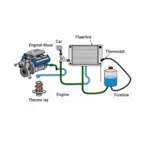The OBD2 port, often located under your car’s dashboard, is a gateway to a wealth of information about your vehicle’s health and performance. By accessing diagnostics through the OBD2 port, car owners and mechanics can unlock valuable insights into potential issues, monitor vital systems, and even enhance their driving experience.
What Can You Access Through an OBD2 Port?
The OBD2 port, short for On-Board Diagnostics, acts as a communication hub for your car’s computer system. By connecting an OBD2 scanner, you can tap into this network and access a wide range of data, including:
- Diagnostic Trouble Codes (DTCs): These codes indicate specific malfunctions within your car’s systems, such as engine misfires, sensor failures, or emissions issues.
- Real-Time Sensor Data: Monitor live data streams from various sensors, including engine speed, coolant temperature, oxygen sensor readings, and more.
- Freeze Frame Data: Capture a snapshot of your car’s sensor readings at the moment a fault code was triggered, providing valuable context for diagnosing issues.
- Vehicle Information: Retrieve essential details about your car, such as VIN, supported protocols, and mileage.
The Benefits of Accessing Diagnostics Through OBD2
Understanding your car’s inner workings offers numerous advantages:
- Early Problem Detection: Identify minor issues before they escalate into major repairs, saving you time and money in the long run.
- Informed Repair Decisions: Arrive at the mechanic with a clearer understanding of the problem, empowering you to make informed decisions about repairs.
- Enhanced Performance Monitoring: Track vital engine parameters and identify potential areas for optimization, potentially improving fuel efficiency and performance.
- DIY Diagnostics and Troubleshooting: Empower yourself to diagnose and address simple car problems without needing specialized tools or expertise.
Choosing the Right OBD2 Scanner
The key to unlocking the full potential of OBD2 diagnostics lies in choosing the right scanner. Consider these factors:
- Compatibility: Ensure the scanner supports your car’s make, model, and year.
- Features: Determine the level of detail and functionality you require, from basic code reading to advanced live data streaming.
- User Interface: Opt for a scanner with a user-friendly interface and clear data presentation.
“Investing in a quality OBD2 scanner is like having a window into your car’s soul. It empowers you with knowledge and can ultimately save you headaches and money.” – John Smith, Senior Automotive Technician*
Common Questions About Accessing Diagnostics Through OBD2 Port
Can I use any OBD2 scanner on my car?
Not all scanners are universally compatible. It’s essential to choose one that supports your car’s make, model, and year.
Is it safe to use an OBD2 scanner?
Using a reputable OBD2 scanner as instructed is generally safe. However, avoid making any modifications or adjustments beyond your understanding.
Do I need to be a mechanic to use an OBD2 scanner?
Many scanners offer user-friendly interfaces that make them accessible to car owners of all technical levels.
What do I do after I get a diagnostic code?
Research the code online or consult a mechanic to understand its meaning and implications for repair.
Take Control of Your Car’s Health Today
Accessing diagnostics through the OBD2 port is no longer reserved for mechanics and technicians. With the right tools and knowledge, you can empower yourself to better understand, maintain, and care for your vehicle.
Need help choosing the right OBD2 scanner for your needs? Contact our team at WhatsApp: +1(641)206-8880, Email: [email protected]. We offer 24/7 customer support and are happy to assist you.


